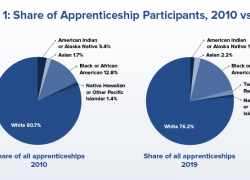A year ago, the Department of Labor’s Chief Evaluation Office solicited proposals for research to help us understand how labor programs and policies reach historically underserved communities. We were especially interested in supporting emerging researchers, and all five of the research teams that received funding included at least one undergraduate or graduate student.
Together, these teams tackled a variety of important questions, helping us understand how data can improve equity across the programs, protections and policies we administer. Today, we are releasing the final papers from these projects for download. Below, we summarize key insights from each project—and you can read more in the full papers.
“Understanding Disparities in Unemployment Insurance Recipiency”
Eliza Forsythe and Hesong Yang, University of Illinois at Urbana-Champaign
Using data from public and private surveys, the authors study demographic differences in access to the unemployment insurance program, both historically and during the COVID-19 pandemic. They also study why some groups—especially younger workers, workers with lower levels of formal education, and workers of color—are less likely to receive benefits, finding that these gaps are attributable to differences in application rates. For instance, 28% of UI-eligible Black workers reported receiving UI benefits during the pandemic, compared to 36% of UI-eligible white workers. This suggests the importance of raising awareness about the application process, especially eligibility, in underserved communities.

“Disparities in Access to Unemployment Insurance During the COVID-19 Pandemic: Lessons from U.S. and California Claims Data”
Alex Bell, TJ Hedin, Roozbeh Moghadam, Geoffrey Schnorr, and Till von Wachter, California Policy Lab
The authors use state administrative data to analyze disparities in UI benefit access, within California and the country overall. They found that within California, UI benefits were more widely accessible in counties that were more affluent, had a lower share of Hispanic workers, and had more access to high-speed broadband internet. These findings can help the department and state UI agencies better understand the communities that are currently underserved by the UI program.
“Can We Use Local Outreach to Improve Equity in Federal Oversight? A Case Study with the H-2A Visa Program”
Rebecca Johnson and Yuchuan Ma of Dartmouth College, Elizabeth Shackney, Texas RioGrande Legal Aid; Cassie Davis, Texas Appleseed
In this paper, the authors study the administration of the H-2A agricultural workers program to understand how the department can better conduct oversight to protect workers’ rights. Partnering with a legal services provider, the authors examine how data from that community partner, merged with the department’s administrative data, can help better predict employers that may be at risk for labor violations. These findings can help us better analyze violations and complaints data, and to partner with community organizations to better reach underserved communities.
“FMLA Eligibility of Underserved Communities”
Kelly Jones and Farah Tasneem, American University
The authors use public surveys to study how differences in the firm size threshold and employee hours threshold for the Family and Medical Leave Act affect workers’ eligibility for leave. Their paper also simulates how worker eligibility for leave would change with different threshold requirements in place. This paper helps us understand barriers to accessing family and medical leave, and potential alternatives to expand access.
“The Role of Labor Market Polarization in Disability among Working-Age Americans”
Sarah Garcia of University, Minnesota-Twin Cities
In this paper, the author studies the connection between changes in labor market structure and rates of disability among working-age Americans. Using multiple sources of survey data, the author identifies close connections between declines in manufacturing jobs and rates of disability, suggesting that deindustrialization may have contributed to rising rates of disability. This paper helps us better understand the long-term landscape of work and its connection to worker health and wellbeing, as well as the role of public policies in supporting workers with disabilities.
We look forward to reviewing these findings and sharing recommendations with our agencies – but we’re not stopping here. We’re launching the second Summer Data Challenge this year, and are again soliciting research projects that can shed light on how labor policies can improve working conditions and outcomes for workers most at risk of having their labor rights violated, and who have historically been excluded and marginalized. This year we’re especially interested in projects that fall into four focus areas:
- public policy responses to the COVID-19 crisis,
- opportunities for supporting worker organizing and collective bargaining,
- labor market competition and power, and
- the impact of workplace technologies on workers.
If you know somebody conducting research in those areas, make sure they know about this opportunity.
Alex Hertel-Fernandez is deputy assistant secretary for research and evaluation at the U.S. Department of Labor.
UI Recipiency Rates, 2021
| Percent of all unemployed workers | Percent of UI-eligible unemployed workers | |
| White | 22% | 36% |
| Asian | 20% | 27% |
| Hispanic | 29% | 46% |
| Black | 13% | 28% |
| Other | 19% | 14% |

 U.S. Department of Labor Blog
U.S. Department of Labor Blog




